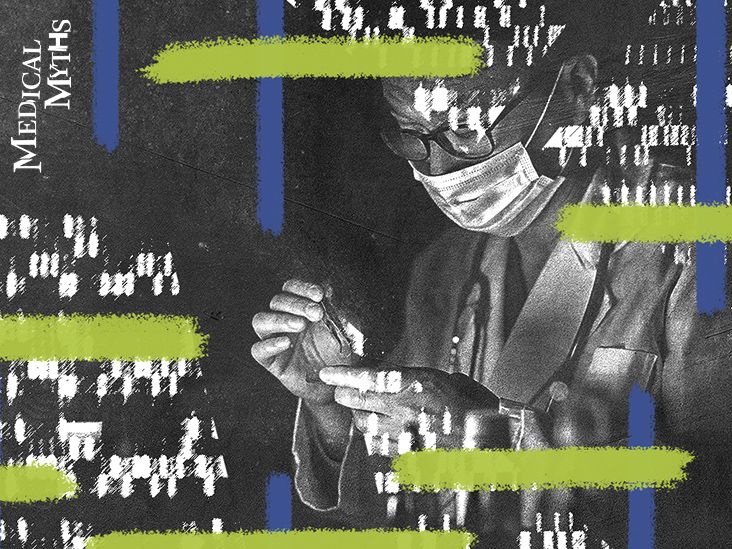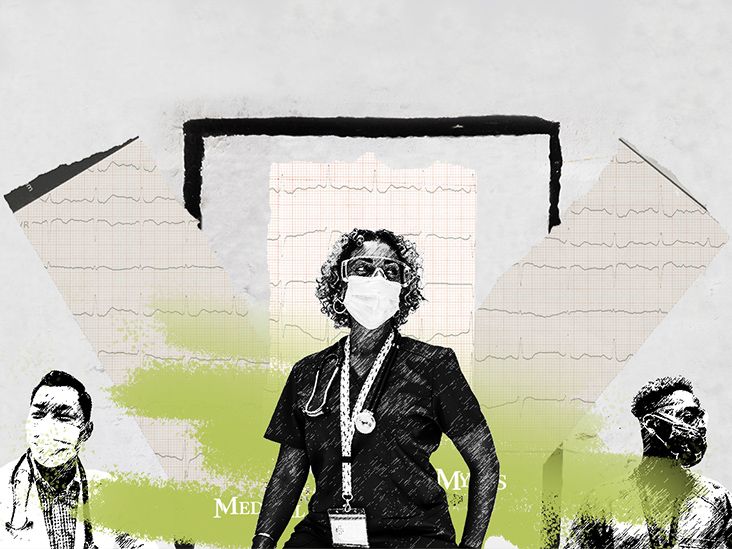
This article was updated on November 8, 2020
The novel coronavirus, SARS-CoV-2, has spread from Wuhan, China, to every continent except Antarctica.
The
The virus has been responsible for tens of millions of infections globally, causing more than a million deaths. The United States has been the most affected country.
As ever, when the word “pandemic” began appearing in headlines, people became fearful — and with fear came misinformation and rumors.
Below, we dissect some of the most common myths currently circulating on social media and beyond.
Coronavirus resources
For more advice on COVID-19 prevention and treatment, visit our coronavirus hub.
1. Spraying chlorine or alcohol on the skin kills viruses in the body
Applying alcohol or chlorine to the skin can cause harm, especially if it enters the eyes or mouth. These chemicals can disinfect surfaces, but people should not use them on their bodies.
Also, these products cannot kill viruses inside the body.
2. Only older adults and people with preexisting conditions are at risk of infections and complications
SARS-CoV-2, like other coronaviruses, can transmit to people of any age. However, older adults and individuals with preexisting health conditions, such as diabetes, obesity, or asthma, are more likely to become severely ill.
While people
3. Children cannot get COVID-19
Anyone, of any age, can develop the infection that causes COVID-19.
So far, most COVID-19 cases have been in adults, but children are not immune. That said,
Also, on May 15, 2020, the
The condition, called
Scientists currently know little about this condition, but
4. COVID-19 is just like the flu
Infection with the virus SARS-CoV-2 can cause COVID-19, an illness that can cause flu-like symptoms, such as body aches, a fever, and a cough. Symptoms of either COVID-19 or the flu can be mild, severe, or rarely, fatal. Both illnesses can also cause pneumonia.
However, the overall profile of COVID-19 is more serious. Different countries have reported different mortality rates, and the case fatality rate in the U.S. appears to be around 2.6%.
While scientists are still determining the exact mortality rate based on developing data, it is likely to be many times higher than that of the seasonal flu.
Learn about the differences between COVID-19 and the flu here.
5. Everyone with COVID-19 dies
This is false. As we explain above, COVID-19 is fatal for a small percentage of people who develop the illness.
The WHO have reported that around
Also, many people with the underlying infection experience no symptoms.
6. Cats and dogs spread the coronavirus
There have been
According to the
Scientists are debating the importance of these cases in animals. For instance, Jonathan Ball, a professor of molecular virology at the University of Nottingham, in the United Kingdom, says:
“We have to differentiate between real infection and just detecting the presence of the virus. I still think it’s questionable how relevant it is to the human outbreak, as most of the global outbreak has been driven by human-to-human transmission.”
7. Face masks always protect against the coronavirus
Healthcare workers use professional face masks that fit tightly to protect themselves from infections.
Disposable and cloth masks can protect against droplets, but neither can protect against aerosolized particles.
The
Even while wearing a mask, it is essential to continue with other precautions, such as not touching the face, physical distancing, and washing the hands frequently.
Instructions for making masks at home are available
Surgical masks and N95 respirators provide greater protection, but reserve these for healthcare workers.
8. Hand dryers kill the coronavirus
Hand dryers
When this is not possible, use an alcohol-based hand sanitizer.
9. SARS-CoV-2 is just a mutated form of the common cold virus
Coronaviruses are a large family, and each has spiky proteins on their surface. Some use humans as their
Other coronaviruses, including SARS-CoV-2, primarily infect animals.
Like COVID-19, Middle East respiratory syndrome (MERS) and severe acute respiratory syndrome (SARS) are caused by coronaviruses. These viruses also initially passed to humans from animals.
10. You have to be with someone for 10 minutes to catch the virus
The longer a person is close to someone with the infection, the likelier the virus is to transmit. However, the virus can pass from person to person in under 10 minutes.
11. Rinsing the nose with saline protects against the coronavirus
There is no evidence that a saline nasal rinse protects against any respiratory infections.
Some research suggests that a rinse might ease the symptoms of acute upper respiratory tract infections, but scientists have not found that this technique reduces the risk of infection.
12. You can protect yourself by gargling bleach
People should never put bleach in their mouths. Gargling bleach could never benefit a person’s health.
Bleach is corrosive and can cause serious damage.
13. Antibiotics kill the coronavirus
Antibiotics only kill bacteria. They do not kill viruses.
14. Thermal scanners can diagnose the coronavirus
Thermal scanners can detect whether someone has a fever — which might result from any number of health issues.
Symptoms of COVID-19 can appear
15. Garlic protects against coronaviruses
Some
There is no evidence that garlic can protect people from COVID-19.
16. Parcels from China can spread the coronavirus
From previous research into coronaviruses similar to SARS-CoV-2, including those that cause SARS and MERS, scientists believe that the virus cannot survive on letters or packages for extended periods.
The
17. Home remedies can cure and protect against COVID-19
No home remedies can protect against COVID-19. This goes for vitamin C, essential oils, silver colloid, sesame oil, garlic, fish tank cleaner, sage, or water, even when a person sips it every 15 minutes.
The best approach is to wash the hands frequently, for 20 seconds at a time, to use an alcohol-based hand sanitizer, to wear a face covering in public, and to avoid crowded places.
18. You can catch the coronavirus from eating Chinese food in the US
No, you cannot.
19. You can catch the coronavirus from urine and feces
This is likely false, but the jury is currently out. According to Prof. John Edmunds, from the London School of Hygiene & Tropical Medicine, in the U.K.:
“It isn’t a very pleasant thought, but every time you swallow, you swallow mucus from your upper respiratory tract. In fact, this is an important defensive mechanism. This sweeps viruses and bacteria down into our gut where they are denatured in the acid conditions of our stomachs.”
“With modern, very highly sensitive detection mechanisms, we can detect these viruses in feces. Usually, the viruses that we can detect in this way are not infectious to others, as they have been destroyed by our guts.”
However, it is worth noting that some
20. The virus will die off when temperatures rise
Some viruses, such as cold and flu viruses, spread more easily in colder months. This does not mean that their transmission stops in warmer weather.
As it stands, scientists
21. The coronavirus is the deadliest virus known to humans
While SARS-CoV-2 does appear to be more dangerous than influenza viruses, it is not the deadliest virus that people have faced. Others, such as the Ebola virus, have higher mortality rates.
22. Flu and pneumonia vaccines can protect against COVID-19
Because SARS-CoV-2 is distinct from other viruses, no existing vaccines can protect against it.
23. The virus originated in a laboratory in China
There is no evidence to back up this rumor, which has circulated on the internet. As a
Some researchers believe that SARS-CoV-2 jumped from
24. The outbreak began because people ate bat soup
While scientists are confident that the virus started in animals, there is no evidence that soup was involved.
25. 5G helps SARS-CoV-2 spread
As the world becomes more connected, some regions are rolling out 5G mobile technology. This has prompted a raft of conspiracy theories.
One of the most recent to emerge is that 5G is responsible for the swift spread of SARS-CoV-2 across the globe. This is a myth.
Some people believe that 5G helps viruses communicate, often citing a paper from 2011. In this study, the authors conclude that bacteria can communicate via electromagnetic signals.
However, experts dispute this theory. In any case, SARS-CoV-2 is a virus, not a bacterium.
Wuhan was one of the first cities to trial 5G in China, which helps explain the origin of some of these theories. However, Beijing, Shanghai, and Guangzhou also rolled out 5G at a similar time.
It is also worth noting that COVID-19 has significantly impacted countries with very little 5G coverage, such as Iran.
Learn about the health implications of 5G in depth here.
26. Drinking alcohol reduces the risk of infection
The WHO have released a response to the series of myths surrounding alcohol and COVID-19. They explain that while alcohol can disinfect the skin, it does not have this effect inside the body.
They continue, “Consuming any alcohol poses health risks, but consuming high-strength ethyl alcohol (ethanol), particularly if it has been adulterated with methanol, can result in severe health consequences, including death.”
Also, in a fact sheet on the subject, they explain that “Alcohol use, especially heavy use, weakens the immune system — and thus reduces the ability to cope with infectious diseases.”
And because alcohol is associated with a number of diseases, it may make people more vulnerable to COVID-19.
27. Injecting or consuming bleach or disinfectant kills the virus
Consuming or injecting disinfectant or bleach does not wipe out viruses in the body, and it can be extremely dangerous.
As Dr. Wayne Carter, an associate professor at the University of Nottingham’s Faculty of Medicine & Health Sciences, in the U.K., explains, “Disinfectants and bleach are strong oxidizing agents, useful to kill bacteria or viruses when they are deposited on surfaces, but these agents should not be ingested or injected. These agents can cause severe tissue burns and blood vessel damage.”
Dr. Penny Ward, a visiting professor of pharmaceutical medicine at King’s College London, in the U.K., notes, “Drinking bleach kills. Injecting bleach kills faster.”
28. You can contract the coronavirus in swimming pools
As the
Still, the virus can transmit in all the usual ways in these and any other shared spaces. A person contracts a SARS-CoV-2 infection by inhaling respiratory droplets that contain the virus or coming into contact with infected surfaces.
As in other public places, the CDC recommend staying 6 feet, or 2 meters, away from others at pools and water parks and wearing cloth face coverings when not in the water.
People who operate pools should take extra care to
In a follow-up article, we explore 5 persistent myths about COVID-19 and shed light on the roles of vitamin C, vitamin D, and zinc.
29. If you get a COVID-19 vaccine, you will no longer transmit SARS-CoV-2 to others
The question as to whether the currently authorized COVID-19 vaccines might stop SARS-CoV-2 transmission altogether has arisen in the context of speculations about “vaccine passports.”
Such documentation would, in theory, allow people who have had a COVID-19 vaccine to move freely once again.
However, at present there is not enough evidence to prove whether or not thecurrently authorized vaccinesstop the spread of the SARS-CoV-2 virus.
The trial results for the
However, research on whether or not these vaccines and other vaccine candidates are also likely to prevent transmission is lacking.
The
- avoiding close contact with people who seem ill or report symptoms
- trying not to touch the eyes, nose, or mouth
- staying home if any symptoms appear
- sneezing into a tissue, then throwing it in the trash, or sneezing into the crook of the elbow
- using standard cleaning sprays and wipes to disinfect frequently touched objects and surfaces
washing the hands with soap regularly, for at least 20 seconds at a time- using an alcohol-based hand sanitizer when soap and water are unavailable
- wearing a cloth face covering in stores, pharmacies, and other public settings
For live updates on the latest developments regarding the novel coronavirus and COVID-19, click here.



